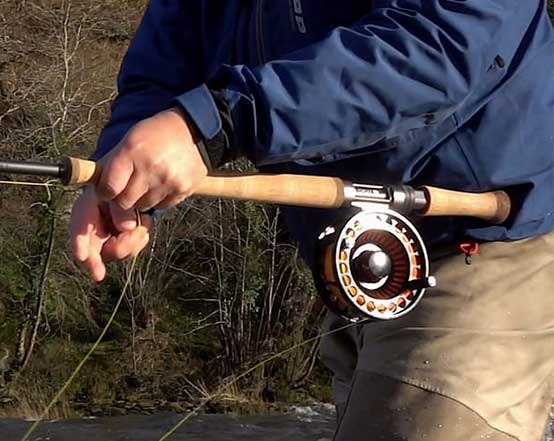Thoughts on Making a Cast
- Remember that you can’t start the cast until you can move the end of the fly line so it is important that fly line is straight with no “slack”.
- Start with the rod tip low and with your casting hand in front of your body, elbow slightly forward of the body and the forearm parallel to the ground.
- To perform the back cast, keeping a firm wrist, draw the hand back in a straight line and stop with the rod pointed up at about slightly less than a 90 degree angle to the ground behind you. This will have the effect of throwing the line up and back so that it unrolls in the air. As you perform this action the rod is loaded (bent or flexed) by the weight of the fly line trailing behind the tip. When the rearward movement of the rod is stopped the rod unflexes and propels the following fly line and the casting loop is formed. If the rod movement is stopped with the rod lower to the ground at the rear, this will have the effect of throwing the line into the ground as the rod unflexes.
- It is important that stop be performed as quickly as possible. The more abrupt the stop, the more power is transferred to the casting loop.
- If the hand movement is executed by more of a rotation rather than a draw back in straight line, this has the effect of moving the rod tip in a semicircular path that results is the formation of a open or wide loop that has little power.
- Before the forward cast can be commenced, the casting action has to pause momentarily to allow the loop to completely unroll and the line to straighten. The hand should remain stationary during the pause. The more line that is in the air the longer the pause has to be.
- The forward cast should be commenced at the instant that the line straightens. This is performed by moving the hand forward smoothly in a punching or throwing motion and stopping the rod sharply with the rod at about 60 degrees to the ground.
- To form a desirable small loop, the rod tip needs to travel in a straight line which means that the hand must move in a straight line. If the hand is moved in a semicircular action, a wide or open loop will result causing a lack of power.
- As well as the tip traveling in a straight line, the rod must also travel in the same plane throughout the casting stroke. This means that if the rod is angled at say 45 degrees to the body, that angle should be maintained on the back cast and the forward cast. If the angle is changed, it will cause the end of the fly line to swing around.
- For short casts that only require a small casting arc keep your hand about as high as your ear. Longer casts with a larger casting arc require an extension of your hand and arm both up and out from your shoulder.
- The line hand should always follow the movement of the casting hand at a consistent distance.



Recent Comments